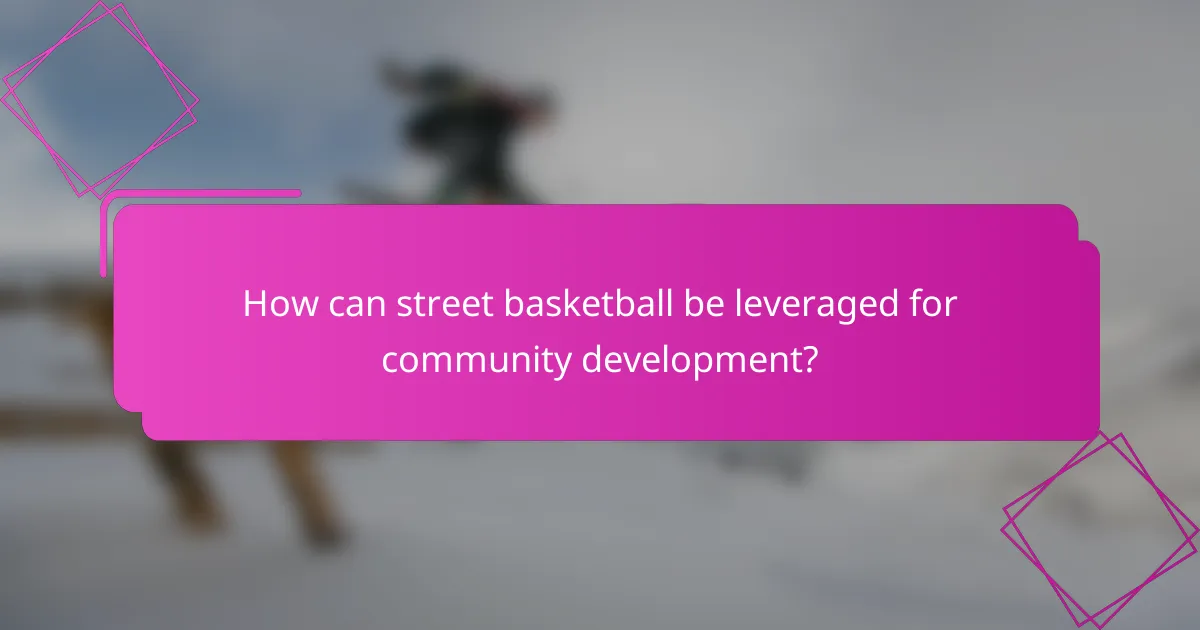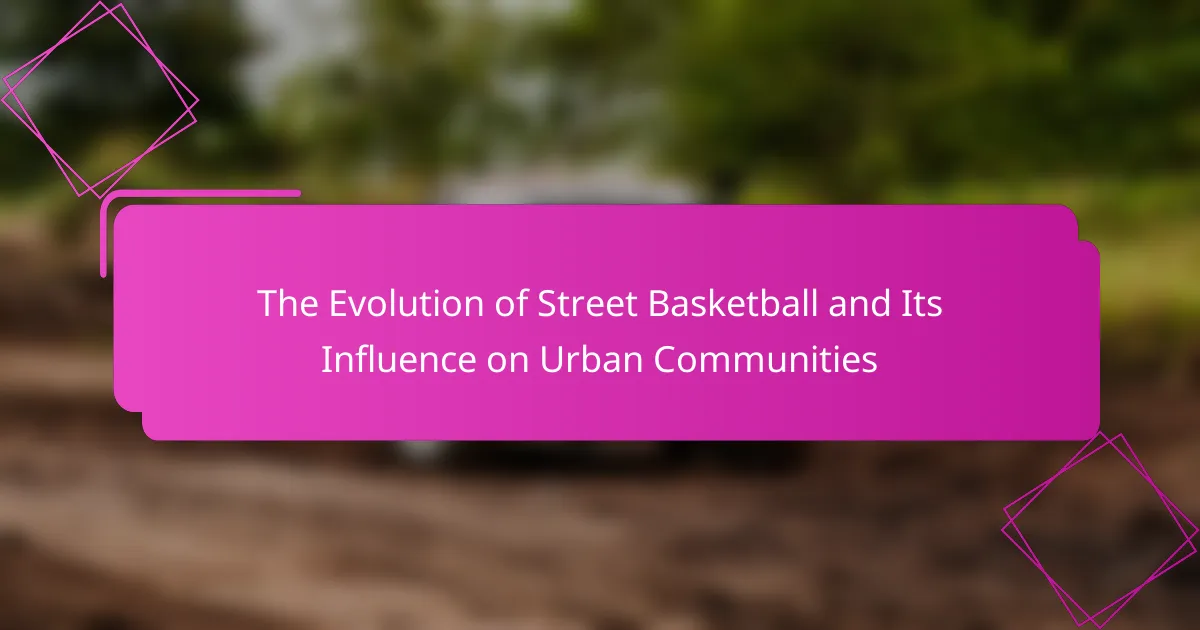Street basketball plays a vital role in shaping urban communities, addressing social issues, and promoting inclusivity. Its evolution reflects cultural shifts, from informal play in the 1970s to a global phenomenon influenced by media and the NBA. The sport fosters community engagement, enhances local economies, and provides positive outlets for youth. Challenges like gentrification and safety concerns threaten its accessibility and cultural significance.

How has street basketball evolved over the decades?
Street basketball has evolved significantly over decades, shaping urban communities and culture. Initially rooted in informal play, it gained popularity in the 1970s with iconic players and tournaments. The rise of hip-hop culture intertwined basketball with music and fashion, enhancing its appeal.
In the 1990s, street basketball became a global phenomenon due to media exposure and the NBA’s influence. Events like the And1 Mixtape Tour showcased streetball talent, emphasizing creativity and style.
Today, street basketball continues to thrive, fostering community engagement and providing opportunities for youth. Urban courts serve as social hubs, promoting teamwork and resilience. The sport’s evolution reflects broader cultural shifts and highlights its role in empowering urban communities.
What cultural shifts influenced the rise of street basketball?
The rise of street basketball was influenced by cultural shifts including urbanization, music, and social movements. Urbanization led to increased population density in cities, creating a need for accessible recreational activities. As hip-hop culture emerged in the 1980s, it intertwined with street basketball, promoting a sense of community and self-expression. Additionally, social movements advocating for civil rights and equality highlighted street basketball as a platform for marginalized voices. This convergence of factors solidified street basketball as a vital aspect of urban culture, shaping its evolution and impact on communities.
Which cities became pivotal in the development of street basketball?
New York City, Los Angeles, Chicago, and Philadelphia became pivotal in the development of street basketball. New York City, especially with its iconic playgrounds, popularized the sport’s cultural significance. Los Angeles contributed through its vibrant streetball scene and celebrity influence. Chicago introduced competitive street tournaments that shaped player skills. Philadelphia is known for its unique playing style and community engagement in basketball culture. These cities collectively fostered street basketball’s evolution, influencing urban communities globally.
How did street basketball intersect with hip-hop culture?
Street basketball significantly influenced hip-hop culture by serving as a platform for expression and community identity. The sport emerged in urban neighborhoods, where it became intertwined with the rhythms and styles of hip-hop music. Players often showcased their skills during block parties and music events, reinforcing a shared cultural experience.
The aesthetics of street basketball, such as fashion and language, reflect hip-hop’s influence. Players adopted unique styles, including specific sneakers and apparel that became symbols of status within both communities. This cross-pollination fostered a sense of belonging among youth in urban areas.
Moreover, street basketball legends often became local heroes, inspiring hip-hop artists and vice versa. Collaborations between basketball players and musicians further solidified this connection, with music videos frequently featuring streetball scenes, enhancing both sports and cultural narratives.
Overall, street basketball and hip-hop culture evolved together, shaping urban communities through shared values of creativity, resilience, and expression.

What are the core values and community aspects of street basketball?
Street basketball embodies core values such as community, resilience, and creativity. It fosters social connections and offers a platform for self-expression in urban environments. Players often form tight-knit communities that support one another, reflecting the unique attribute of inclusivity. Additionally, street basketball promotes physical fitness and mental well-being, serving as a positive outlet for youth. Its evolution has influenced urban culture, transforming public spaces into vibrant hubs for collaboration and competition.
How does street basketball foster community engagement?
Street basketball fosters community engagement by creating inclusive spaces for social interaction and teamwork. It encourages local youth to participate in physical activity, promoting health and well-being. The informal nature of street basketball allows diverse groups to connect, breaking down social barriers. Events and tournaments further strengthen community bonds, showcasing local talent and fostering pride. These gatherings can also address social issues, encouraging dialogue and collaboration among residents.
What role does street basketball play in youth development?
Street basketball plays a crucial role in youth development by fostering teamwork, discipline, and self-esteem. It provides a platform for social interaction and community engagement. Through participation, youth learn essential life skills such as leadership and conflict resolution. Additionally, street basketball serves as an outlet for physical activity, promoting health and fitness. The informal nature of the game encourages creativity and adaptability, allowing players to express themselves while navigating challenges.

Which unique styles and variations exist in street basketball globally?
Street basketball showcases unique styles and variations across the globe, influenced by local culture and community. In the United States, the playground style emphasizes creativity and individual expression. European street basketball often incorporates tactical teamwork and structured play. In Asia, particularly in the Philippines, street basketball features intense competition with a strong community focus, often played in makeshift courts. Africa exhibits a blend of improvisation and traditional games, reflecting local customs. Each region’s unique attribute enriches the global street basketball landscape, fostering a diverse and vibrant culture.
How do local rules and play styles differ across regions?
Local rules and play styles in street basketball vary significantly across regions due to cultural influences and community dynamics. For instance, urban areas often emphasize fast-paced games and improvisation, while suburban regions may focus on structured play and teamwork.
In cities like New York, street basketball features unique moves and a strong emphasis on individual talent. Conversely, in Los Angeles, players often incorporate elements of showmanship and flair. These variations reflect the urban communities’ values and social interactions.
Additionally, some regions have established specific rules regarding game duration and player conduct. For example, in Chicago, games may prioritize a first-to-11 scoring system, while other areas might follow traditional 21-point games. These local adaptations enhance community engagement and foster a sense of identity among players.
What are some notable street basketball tournaments or leagues?
Notable street basketball tournaments include the Red Bull King of the Rock, the Nike NYC Streetball League, and the Entertainer’s Basketball Classic. These events showcase top talent and foster community engagement in urban areas. The Red Bull King of the Rock emphasizes individual skill, while the Nike NYC Streetball League promotes team play. The Entertainer’s Basketball Classic combines entertainment and competition, attracting diverse audiences. Such tournaments significantly contribute to the evolution of street basketball and its cultural impact.

How does street basketball impact social issues in urban areas?
Street basketball significantly impacts social issues in urban areas by fostering community engagement and providing youth with positive outlets. It serves as a platform for social interaction, bridging cultural divides and promoting teamwork.
The sport empowers individuals by enhancing self-esteem and encouraging leadership skills. For example, youth involved in street basketball often develop a sense of belonging, which can reduce crime rates and promote positive behavior.
Moreover, street basketball initiatives can address urban challenges, such as lack of recreational spaces and youth violence. Programs that incorporate basketball into community development frequently lead to improved social cohesion and community pride.
In summary, street basketball influences urban communities by addressing social issues, promoting inclusivity, and providing constructive activities for youth.
What role does street basketball play in promoting social justice?
Street basketball plays a significant role in promoting social justice by fostering community engagement and providing a platform for expression. It serves as a space for marginalized voices, allowing players to address social issues through the sport.
The informal nature of street basketball encourages inclusivity, breaking down barriers related to race, class, and gender. Players from diverse backgrounds come together, creating a sense of unity and shared purpose. This collective experience can lead to grassroots movements advocating for change.
Moreover, street basketball often highlights local social justice issues, with players using their influence to raise awareness. For instance, community events and tournaments can focus on themes like police reform or education equity, mobilizing participants and spectators alike.
In summary, street basketball not only entertains but also empowers urban communities to confront and challenge social injustices, making it a vital tool for change.
How does street basketball address issues of inequality and access?
Street basketball fosters equality and access by providing free recreational spaces and promoting community engagement. It serves as a platform for social integration, allowing individuals from diverse backgrounds to connect. The informal nature of street basketball facilitates participation regardless of socioeconomic status, breaking down barriers to access. As a result, it empowers marginalized youth, offering them opportunities for personal development and teamwork. This grassroots movement has influenced urban policy, leading to investments in public courts and youth programs, enhancing community resources.

What are the economic influences of street basketball on urban communities?
Street basketball significantly boosts urban economies by fostering community engagement and creating job opportunities. It attracts local businesses and promotes youth development through organized events. Additionally, street basketball enhances public spaces, increasing foot traffic and local investments. The sport also provides a platform for social interaction and cultural expression, strengthening community ties.
How do local businesses benefit from street basketball culture?
Local businesses benefit from street basketball culture by engaging with the community, enhancing brand visibility, and driving foot traffic. These businesses often sponsor local tournaments, creating a positive association with the sport. As a result, they attract more customers who participate in or watch these events. Street basketball fosters a sense of community, encouraging loyalty among local patrons. Additionally, the vibrant atmosphere of street basketball can lead to increased sales during events, providing a unique opportunity for local enterprises to thrive.
What are the sponsorship and branding opportunities in street basketball?
Sponsorship and branding opportunities in street basketball are extensive and impactful. Brands can engage with urban communities through team sponsorships, local tournaments, and community events.
1. Team Sponsorships: Companies can sponsor local street basketball teams, enhancing brand visibility and community goodwill.
2. Event Sponsorship: Partnering with street basketball tournaments offers brands exposure and the chance to connect with a diverse audience.
3. Merchandising Collaborations: Collaborating on apparel and gear can strengthen brand identity while supporting local athletes.
4. Digital Engagement: Brands can leverage social media campaigns to engage with fans and promote events, creating a dynamic online presence.
5. Community Initiatives: Supporting youth programs or clinics fosters brand loyalty and demonstrates social responsibility.
These opportunities not only promote products but also contribute to the cultural significance of street basketball in urban settings.

What challenges does street basketball face in modern urban environments?
Street basketball faces significant challenges in modern urban environments, including gentrification, safety concerns, and limited access to public spaces. Gentrification often leads to the displacement of local players as neighborhoods transform, reducing community engagement. Safety concerns arise from crime and traffic, deterring participation. Limited access to public spaces restricts available courts, making it harder for players to find places to play. These factors collectively hinder the growth and accessibility of street basketball, impacting its cultural significance in urban communities.
How are gentrification and urban development affecting street basketball?
Gentrification and urban development are reshaping street basketball by reducing accessible spaces and altering community dynamics. As neighborhoods undergo transformation, courts are often replaced with commercial developments, limiting play areas. Additionally, rising rents displace local players, disrupting established street basketball cultures. Urban development can also lead to the construction of new facilities, but these often cater to wealthier demographics, further marginalizing traditional street basketball communities. The evolution of street basketball reflects these changes, highlighting the tension between urban progress and community identity.
What safety concerns arise in street basketball settings?
Street basketball settings pose several safety concerns, including injuries, violence, and inadequate facilities. Players often face risks from uneven surfaces, which can lead to sprains or fractures. Additionally, conflicts may arise from competitive play, resulting in physical altercations. The lack of proper lighting at night increases the likelihood of accidents. Furthermore, public spaces may not have adequate supervision, heightening the risk of theft or vandalism. Addressing these issues is crucial for fostering a safer environment in urban communities where street basketball thrives.

How can street basketball be leveraged for community development?
Street basketball can foster community development by promoting social cohesion, providing safe recreational spaces, and encouraging youth engagement. It acts as a platform for cultural exchange and empowerment, enhancing local identity.
The sport attracts diverse groups, creating opportunities for collaboration among residents. For example, community tournaments can unite neighborhoods, instilling pride and teamwork. As a result, street basketball can reduce crime rates by engaging youth in positive activities.
Investment in public courts can improve local infrastructure, leading to economic benefits. Enhanced facilities attract visitors, which can stimulate local businesses. Furthermore, partnerships with local organizations can provide mentorship programs, fostering leadership skills among participants.
Overall, street basketball serves as a catalyst for community growth, blending recreation with social development.
What best practices exist for organizing street basketball events?
To organize street basketball events effectively, focus on community engagement, logistics, and promotion. Engage local players and stakeholders to foster participation. Ensure proper venue selection, securing permits, and arranging equipment. Promote the event through social media and local networks to maximize attendance.
How can local governments support street basketball initiatives?
Local governments can significantly support street basketball initiatives by providing funding, facilities, and community programs. These efforts foster youth engagement and promote healthy lifestyles.
Investment in public courts enhances accessibility for all community members. Local governments can organize tournaments and events, creating opportunities for skill development and community bonding. Collaborating with local organizations can amplify outreach and resources, ensuring diverse participation.
Creating mentorship programs connects experienced players with youth, cultivating talent and fostering a sense of belonging. Additionally, promoting street basketball through social media campaigns can raise awareness and encourage community support.
Overall, local governments play a crucial role in the growth and sustainability of street basketball, positively impacting urban communities.
What strategies can enhance the positive impact of street basketball on communities?
Community engagement and youth development programs can enhance the positive impact of street basketball. These initiatives foster teamwork, discipline, and leadership skills among participants.
Organizing tournaments and events encourages local participation, strengthening community bonds. Collaborations with schools and local organizations provide resources and mentorship, creating a supportive environment for players.
Promoting inclusivity in street basketball allows diverse groups to connect, fostering understanding and cooperation. Investing in safe and accessible courts ensures that everyone can participate, further enhancing community cohesion.
Sustained outreach and educational efforts about the benefits of street basketball can inspire more individuals to engage, maximizing its social impact.
